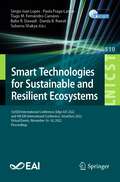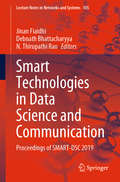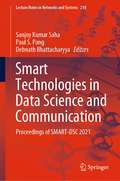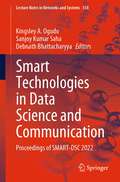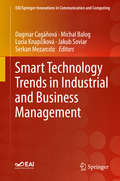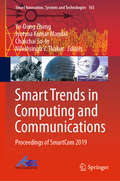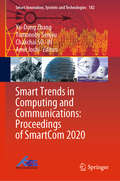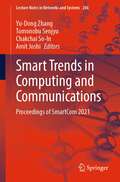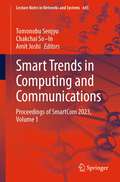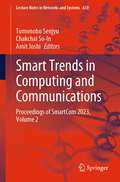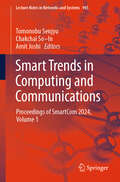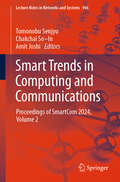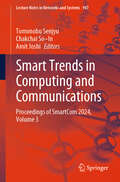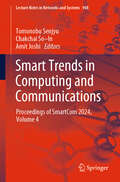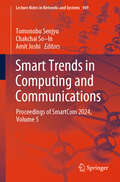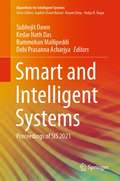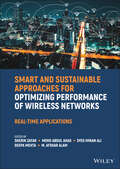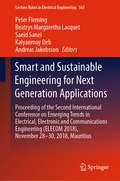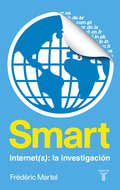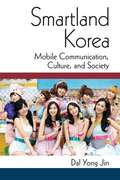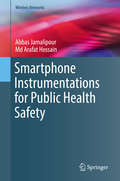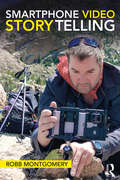- Table View
- List View
Smart Technologies for Sustainable and Resilient Ecosystems: 3rd EAI International Conference, Edge-IoT 2022, and 4th EAI International Conference, SmartGov 2022, Virtual Events, November 16-18, 2022, Proceedings (Lecture Notes of the Institute for Computer Sciences, Social Informatics and Telecommunications Engineering #510)
by Danda B. Rawat Subarna Shakya Sérgio Ivan Lopes Paula Fraga-Lamas Tiago M. Fernándes-Camáres Babu R. DawadiThis book constitutes the jointly proceedings of the 3rd International Conference on Intelligent Edge Processing in the IoT Era, Edge-IoT 2022, and the 4th International Conference on Smart Governance for Sustainable Smart Cities, SmartGov 2022. Both conferences were held online due to COVID-19 pandemic in November 2022, held as virtual events, in November 16-18, 2022.The 12 full papers were selected from 31 submissions. SmartGov 2022 was to promote the development of secure and sustainable smart cities with smart governance, while the theme of Edge-IoT 2022 was to address the decentralization of contemporary processing paradigms, notably Edge processing, focusing on the increasing demand for intelligent processing at the edge of the network, which is paving the way to the Intelligent IoT Era”. Both the EAI SmartGov 2022 and EAI Edge-IoT 2022 conferences were co-located with EAI SmartCity360 international convention.The papers are organized in the following topical sections: Edge-IoT Applications; IoT Architectures, Forecasting and Adversarial Training; Artificial Intelligence and Machine Learning for smart governance; and Smart Transportation.
Smart Technologies in Data Science and Communication: Proceedings of SMART-DSC 2019 (Lecture Notes in Networks and Systems #105)
by Jinan Fiaidhi Debnath Bhattacharyya N. Thirupathi RaoThis book features high-quality, peer-reviewed research papers presented at the International Conference on Smart Technologies in Data Science and Communication (Smart-DSC 2019), held at Vignan’s Institute of Information Technology (Autonomous), Visakhapatnam, Andhra Pradesh, India on 13–14 December 2019. It includes innovative and novel contributions in the areas of data analytics, communication and soft computing.
Smart Technologies in Data Science and Communication: Proceedings of SMART-DSC 2021 (Lecture Notes in Networks and Systems #210)
by Debnath Bhattacharyya Sanjoy Kumar Saha Paul S. PangThis book features high-quality, peer-reviewed research papers presented at the Fourth International Conference on Smart Technologies in Data Science and Communication (SMART-DSC 2021), held in Koneru Lakshmaiah Education Foundation, Guntur, Andhra Pradesh, India, on 18–19 February 2021. It includes innovative and novel contributions in the areas of data analytics, communication, and soft computing.
Smart Technologies in Data Science and Communication: Proceedings of SMART-DSC 2022 (Lecture Notes in Networks and Systems #558)
by Debnath Bhattacharyya Sanjoy Kumar Saha Kingsley A. OgudoThis book features high-quality, peer-reviewed research papers presented at the Fifth International Conference on Smart Technologies in Data Science and Communication (SMARTDSC 2022), held Koneru Lakshmaiah Education Foundation, Guntur, Andhra Pradesh, India, on 16 – 17 June 2022. It includes innovative and novel contributions in the areas of data analytics, communication and soft computing.
Smart Technology Trends in Industrial and Business Management (EAI/Springer Innovations in Communication and Computing)
by Dagmar Cagáňová Michal Balog Lucia Knapčíková Jakub Soviar Serkan MezarcıözThis book presents current developments in smart city research and application regarding the management of manufacturing systems, Industry 4.0, transportation, and business management. It suggests approaches to incorporating smart city innovations into manufacturing systems, with an eye towards competitiveness in a global environment. The same pro-innovative approach is then applied to business and cooperation management. The authors also present smart city transportation solutions including vehicle data processing/reporting system, mobile application for fleet managers, bus drivers, bus passengers and special applications for smart city buses like passenger counting system, IP cameras, GPS system etc. The goal of the book is to establish channels of communication and disseminate knowledge among researchers and professionals working on smart city research and application. Features contributions on a variety of topics related to smart cities from global researchers and professionals in a wide range of sectors;Presents topics relating to smart cities such as manufacturing, business, and transportation;Includes expanded selected papers from EAI International Conference on Management of Manufacturing Systems (MMS 2016), EAI Industry of Things and Future Technologies Conference – Mobility IoT 2016 and International Conference on Smart Electric Vehicles and Vehicular Ad-hoc NETworks (SEVNET).
Smart Trends in Computing and Communications: Proceedings of SmartCom 2019 (Smart Innovation, Systems and Technologies #165)
by Jyotsna Kumar Mandal Yu-Dong Zhang Chakchai So-In Nileshsingh V. ThakurThis book gathers high-quality papers presented at the International Conference on Smart Trends for Information Technology and Computer Communications (SmartCom 2019), organized by the Global Knowledge Research Foundation (GR Foundation) from 24 to 25 January 2019. It covers the state-of-the-art and emerging topics pertaining to information, computer communications, and effective strategies for their use in engineering and managerial applications. It also explores and discusses the latest technological advances in, and future directions for, information and knowledge computing and its applications.
Smart Trends in Computing and Communications: Proceedings of SmartCom 2020 (Smart Innovation, Systems and Technologies #182)
by Amit Joshi Yu-Dong Zhang Tomonoby Senjyu Chakchai So–inThis book gathers high-quality papers presented at the International Conference on Smart Trends for Information Technology and Computer Communications (SmartCom 2020), organized by the Global Knowledge Research Foundation (GR Foundation) from 23 to 24 January 2020. It covers the state-of-the-art and emerging topics in information, computer communications, and effective strategies for their use in engineering and managerial applications. It also explores and discusses the latest technological advances in, and future directions for, information and knowledge computing and its applications.
Smart Trends in Computing and Communications: Proceedings of SmartCom 2021 (Lecture Notes in Networks and Systems #286)
by Amit Joshi Yu-Dong Zhang Tomonobu Senjyu Chakchai So-InThis book gathers high-quality papers presented at the Fifth International Conference on Smart Trends in Computing and Communications (SmartCom 2021), organized by Global Knowledge Research Foundation (GR Foundation) from March 2 – 3 , 2021. It covers the state of the art and emerging topics in information, computer communications, and effective strategies for their use in engineering and managerial applications. It also explores and discusses the latest technological advances in, and future directions for, information and knowledge computing and its applications.
Smart Trends in Computing and Communications: Proceedings of SmartCom 2023, Volume 1 (Lecture Notes in Networks and Systems #645)
by Amit Joshi Tomonobu Senjyu Chakchai So–InThis book gathers high-quality papers presented at the Seventh International Conference on Smart Trends in Computing and Communications (SmartCom 2022), organized by Global Knowledge Research Foundation (GR Foundation) from January 24–25, 2023, in Jaipur, India. It covers the state-of-the-art and emerging topics in information, computer communications, and effective strategies for their use in engineering and managerial applications. It also explores and discusses the latest technological advances in, and future directions for, information and knowledge computing and its applications.
Smart Trends in Computing and Communications: Proceedings of SmartCom 2023, Volume 2 (Lecture Notes in Networks and Systems #650)
by Amit Joshi Tomonobu Senjyu Chakchai So-InThis book gathers high-quality papers presented at the Seventh International Conference on Smart Trends in Computing and Communications (SmartCom 2022), organized by Global Knowledge Research Foundation (GR Foundation) from January 24–25, 2023, in Jaipur, India. It covers the state-of-the-art and emerging topics in information, computer communications, and effective strategies for their use in engineering and managerial applications. It also explores and discusses the latest technological advances in, and future directions for, information and knowledge computing and its applications.
Smart Trends in Computing and Communications: Proceedings of SmartCom 2024, Volume 1 (Lecture Notes in Networks and Systems #945)
by Amit Joshi Tomonobu Senjyu Chakchai So–InThis book gathers high-quality papers presented at the Eighth International Conference on Smart Trends in Computing and Communications (SmartCom 2024), organized by Global Knowledge Research Foundation (GR Foundation) from 12 to 13 January 2024 in Pune, India. It covers the state-of-the-art and emerging topics in information, computer communications, and effective strategies for their use in engineering and managerial applications. It also explores and discusses the latest technological advances in, and future directions for, information and knowledge computing and its applications.
Smart Trends in Computing and Communications: Proceedings of SmartCom 2024, Volume 2 (Lecture Notes in Networks and Systems #946)
by Amit Joshi Tomonobu Senjyu Chakchai So–InThis book gathers high-quality papers presented at the Eighth International Conference on Smart Trends in Computing and Communications (SmartCom 2024), organized by Global Knowledge Research Foundation (GR Foundation) from 12 to 13 January 2024 in Pune, India. It covers the state-of-the-art and emerging topics in information, computer communications, and effective strategies for their use in engineering and managerial applications. It also explores and discusses the latest technological advances in, and future directions for, information and knowledge computing and its applications.
Smart Trends in Computing and Communications: Proceedings of SmartCom 2024, Volume 3 (Lecture Notes in Networks and Systems #947)
by Amit Joshi Tomonobu Senjyu Chakchai So–InThis book gathers high-quality papers presented at the Eighth International Conference on Smart Trends in Computing and Communications (SmartCom 2024), organized by Global Knowledge Research Foundation (GR Foundation) from 12 to 13 January 2024 in Pune, India. It covers the state-of-the-art and emerging topics in information, computer communications, and effective strategies for their use in engineering and managerial applications. It also explores and discusses the latest technological advances in, and future directions for, information and knowledge computing and its applications.
Smart Trends in Computing and Communications: Proceedings of SmartCom 2024, Volume 4 (Lecture Notes in Networks and Systems #948)
by Amit Joshi Tomonobu Senjyu Chakchai So–InThis book gathers high-quality papers presented at the Eighth International Conference on Smart Trends in Computing and Communications (SmartCom 2024), organized by Global Knowledge Research Foundation (GR Foundation) from 12 to 13 January 2024 in Pune, India. It covers the state-of-the-art and emerging topics in information, computer communications, and effective strategies for their use in engineering and managerial applications. It also explores and discusses the latest technological advances in, and future directions for, information and knowledge computing and its applications.
Smart Trends in Computing and Communications: Proceedings of SmartCom 2024, Volume 5 (Lecture Notes in Networks and Systems #949)
by Amit Joshi Tomonobu Senjyu Chakchai So–InThis book gathers high-quality papers presented at the Eighth International Conference on Smart Trends in Computing and Communications (SmartCom 2024), organized by Global Knowledge Research Foundation (GR Foundation) from 12 to 13 January 2024 in Pune, India. It covers the state-of-the-art and emerging topics in information, computer communications, and effective strategies for their use in engineering and managerial applications. It also explores and discusses the latest technological advances in, and future directions for, information and knowledge computing and its applications.
Smart Villages: Bridging the Global Urban-Rural Divide
by V. Kumar Murty Arun Chockalingam V. I. Lakshmanan S. KalyanasundaramThis book brings together technical expertise, best practices, case studies and ground-level application of the ideas for empowering the rural population of the world to live economically prosperous, environmentally sustainable, and socially progressive lives, on par or comparable with the quality of life enjoyed by the global urban population. The idea of Smart Villages takes on greater urgency in light of the investments made in this millennium on “Smart Cities”, taking advantage of the technological advances, particularly in digital connectivity. These investments have and will continue to expand the urban-rural divide, unless similar investments are made in the villages as well. The book provides a much-needed guide for a holistic development of a Smart Village, by defining the need, developing the framework, and describing the delivery, complete with successful case studies. Contributors to the book, from Canada, USA, Africa and India bring years of academic, industry and governmental experience, including organization of several Smart Village conferences. The knowledge base in the book will be of great value to anyone interested in or active in rural planning, including governmental and non-governmental organizations, industrial solution providers, public healthcare professionals, public policy professionals and students, as well as rural communities around the world. Consolidates all the aspects of creating/developing a Smart Village;Delivers an effective tool-kit for practitioners in the area of Smart Villages;Provides a policy-based framework for the development of an ideal Smart Village;Illustrates, through case studies, the fulfillment of key requirements of a Smart Village;Brings together experts from around the world to share their vision of a Smart Village;Highlights the importance of balancing development with social/gender equity and cultural traditions.
Smart and Intelligent Systems: Proceedings of SIS 2021 (Algorithms for Intelligent Systems)
by Kedar Nath Das Subhojit Dawn Debi Prasanna Acharjya Rammohan MallipeddiThis book is a collection of high-quality research papers presented at the International Conference on Smart and Intelligent Systems (SIS 2021), which will be held in Velagapudi Ramakrishna Siddhartha Engineering College (VRSEC), Andhra Pradesh, India, during February 25–26, 2021, in virtual mode. It highlights how recent informatics intelligent systems have successfully been used to develop innovative smart techniques and infrastructure in the field of modern engineering and technology. The book will also be of interest to those working in the field of computational intelligence, smart computer network and security analysis, control and automation system, cloud computing, fog computing and IoT, smart grid communication, smart cities, solar cell synthesis and their performance, green technology, and many more. The contents of this book prove useful to researchers and professionals.
Smart and Sustainable Approaches for Optimizing Performance of Wireless Networks: Real-time Applications
by Mohd Abdul Ahad Sherin Zafar M. Afshar Alam Syed Imran Ali Deepa MehtaSMART AND SUSTAINABLE APPROACHES FOR OPTIMIZING PERFORMANCE OF WIRELESS NETWORK Explores the intersection of sustainable growth, green computing and automation, and performance optimization of 5G wireless networks Smart and Sustainable Approaches for Optimizing Performance of Wireless Networks explores how wireless sensing applications, green computing, and Big Data analytics can increase the energy efficiency and environmental sustainability of real-time applications across areas such as healthcare, agriculture, construction, and manufacturing. Bringing together an international team of expert contributors, this authoritative volume highlights the limitations of conventional technologies and provides methodologies and approaches for addressing Quality of Service (QOS) issues and optimizing network performance. In-depth chapters cover topics including blockchain-assisted secure data sharing, smart 5G Internet of Things (IoT) scenarios, intelligent management of ad hoc networks, and the use of Artificial Intelligence (AI), Machine Learning (ML) and Deep Learning (DL) techniques in smart healthcare, smart manufacturing, and smart agriculture. Covers design, implementation, optimization, and sustainability of wireless and sensor-based networks Discusses concepts of sustainability and green computing as well as their relevance to society and the environment Addresses green automation applications in various disciplines such as computer science, nanoscience, information technology (IT), and biochemistry Explores various smart and sustainable approaches for current wireless and sensor-based networks Includes detailed case studies of current methodologies, applications, and implementations Smart and Sustainable Approaches for Optimizing Performance of Wireless Networks: Real-time Applications is an essential resource for academic researchers and industry professionals working to integrate sustainable development and Information and Communications Technology (ICT).
Smart and Sustainable Engineering for Next Generation Applications: Proceeding of the Second International Conference on Emerging Trends in Electrical, Electronic and Communications Engineering (ELECOM 2018), November 28–30, 2018, Mauritius (Lecture Notes in Electrical Engineering #561)
by Peter Fleming Kalyanmoy Deb Saeid Sanei Beatrys Margaretha Lacquet Andreas JakobssonThis book reports on advanced theories and methods in two related engineering fields: electrical and electronic engineering, and communications engineering and computing. It highlights areas of global and growing importance, such as renewable energy, power systems, mobile communications, security and the Internet of Things (IoT). The contributions cover a number of current research issues, including smart grids, photovoltaic systems, wireless power transfer, signal processing, 4G and 5G technologies, IoT applications, mobile cloud computing and many more. Based on the proceedings of the Second International Conference on Emerging Trends in Electrical, Electronic and Communications Engineering (ELECOM 2018), held in Mauritius from November 28 to 30, 2018, the book provides graduate students, researchers and professionals with a snapshot of the state-of-the-art and a source of new ideas for future research and collaborations.
Smart, Not Loud: How to Get Noticed at Work for All the Right Reasons
by Jessica ChenEver wonder why the &“loud&” people at work get noticed, rewarded, and promoted? Do you worry that you need to be loud to succeed at work, too?When Jessica Chen entered the workforce, she felt like everything she had been taught growing up in a Quiet Culture household—where deference, humility, harmony, and dogged hard work were praised—failed to set her up for success in the &“real world.&” Her ingrained values were in direct contrast with what was actually needed to stand out in a Loud Culture workplace. The result? Feeling underappreciated, passed over for opportunities and promotions, and completely stuck.Building on the lessons she learned as an award-winning TV news journalist, Chen—who now speaks at Fortune 100 companies and whose LinkedIn Learning courses have been watched by over 2 million people—introduces a new way of getting noticed at work, without being loud, aggressive, or boastful. In Smart, Not Loud, Chen teaches readers how they can look within, to the values they already hold, to more effectively show up. Through instructive anecdotes and research-backed principles, readers will learn to:speak up at meetings using the 4A Sequence (active listening, acknowledging, anchoring, and answering); advocate for themselves with tact;build strategic relationships to enhance credibility and get picked for the best projects;and master the five elements of voice—pitch, rate, intensity, inflection, and quality—to be the kind of communicator others want to listen to.Packed with actionable tips, Smart, Not Loud unveils a new path to getting noticed and getting ahead at work. This is the road map readers need to authentically show up in the workplace and truly feel seen.
Smart. Internet(s): una investigación
by Frédéric Martel<P>Un análisis sorprendente del uso de internet y las redes sociales en el mundo, por el aclamado autor de Cultura Mainstream ¿Cómo ha podido China crear sus propios clones de Google, Facebook y YouTube? ¿De qué manera los países árabes supieron emplear las redes sociales para emprender sus revoluciones? ¿Debemos temer que el inglés se convierta en la lengua empleada «por defecto» en Internet? <P>De Silicon Valley a Tokio, de Brasil a Washington, de Sudáfrica a la India y llegando hasta Cuba o Gaza, Frédéric Martel emprende una investigación sin precedentes, sobre el terreno, y hace un análisis profundo del protagonismo y la influencia de internet y las redes sociales en el mundo, demostrando que hay tantos internets como países. <P>Este enfoque del tema, novedoso y optimista, da cuenta de un mundo mucho más smart de lo que pensábamos, en el que se respetan las singularidades nacionales, las identidades y las diferenciaslocales. No debemos temer el mundo digitalizado: el futuro de internet depende del uso que se haga de él.
Smartland Korea: Mobile Communication, Culture, and Society
by Dal Yong JinThe dramatic advancement of cellphone technology has fundamentally changed our daily lives. Smartphones and their applications have created new capital for information and communication technology corporations and changed the way people communicate. Because of an interesting awareness of the significance for digital economy and people’s daily culture, many countries, from the U.S. to China, have massively invested in the smartphone industries since the early 21st century. Among them, South Korea has become one of the centers for technology development and digital culture, although the country was once lagging behind in the penetration of the phones and their apps. Yet within the last few years, the country has taken a big step toward their goal of becoming a ‘mobile game wonderland’ by appropriating smartphones and it now exists as a curious test-bed for the future of smartphone technology. Smartland Korea, as the first attempt to comprehensively analyze mobile communication in the context of Korean smartphones, looks into a largely neglected focus of inquiry, a localized mobile landscape, with particular reference to young Koreans’ engagement with their devices and applications. Dal Yong Jin focuses not only on the celebratory achievement of technological advancement, but also the significance of social milieu in the development of the smartphones. He situates the emergence of smartphones within the growth of mobile technologies and overall telecommunications industries embedded in Korea’s information and communication technologies. The book examines the technology’s innovation and the evolution, the digital economy through the lens of political economy, and the youth culture embedded in the Korean smartphone context.
Smartphone E-commerce: Your Step-by-step Guide On How To Maximize Sales In Your Mobile E-commerce Store
by Benjamin GundgaardMAXIMIZE your mobile e-commerce sales! <P><P>This step-by-step guide enables you to create world-class smartphone e-commerce stores that maximize your online sales!As Tamara Adlin, CEO at Adlin Inc. and former Customer Experience Manager at Amazon.com, puts it: "Implement even a few of Gundgaard's guidelines and watch your conversion climb!" <P><P>Here's what you get with Smartphone E-commerce:Best practice online shop templates & checklists to build an entire mobile store <P><P>This book guides you through all aspects of how to create lucrative e-commerce stores for smartphones, specifically tailored to maximize your profits and customer satisfaction in the future of online shopping. <P><P>Smartphone E-commerce provides you with templates & 204 guidelines for all parts of your smartphone e-commerce
Smartphone Instrumentations for Public Health Safety (Wireless Networks)
by Abbas Jamalipour Md Arafat HossainA significant and convenient approach to detection and analysis of biological, environmental and agricultural items is the harnessing of features in widely available smartphones to create field-deployable scientific instruments, allowing measurements to be made onsite and in real-time. This book will cover a number of self-contained smartphone instruments with the particular focus on spectroscopic-based measurements. Measurement and analysis on precision of such low-cost instrumentations are provided to compare with more expensive commercial equipment. This book also discusses some limitations, possible recommendations and scopes for further instrumentations using smartphones and other smart devices. Particularly, the opportunity to integrate the devices into the global Internet-of-Things (IoT) platform will be discussed. Researchers and instrumentation designers in optical and photonic sensing, smart and IoT-based sensing, biological and environmental analysts, agricultural, and food quality researchers (and public health authorities) will find this book useful as reference. Students in science and engineering disciplines for teaching and educational purposes will also find this book useful as a secondary textbook.
Smartphone Video Storytelling
by Robb MontgomerySmartphone Video Storytelling helps readers master the techniques for making compelling short-form video content with a smartphone. With mobile journalism on the rise, it’s becoming increasingly important to understand the entire process and potential for conveying stories across multiple platforms. This richly illustrated text provides students with the essential smartphone video reporting skills: From choosing the right editing app to working with interview subjects on camera. The ethics of non-fiction video storytelling are highlighted to reinforce core journalistic principles. The chapters feature mini-tutorials and exercises that introduce the key principles of filmmaking. The student exercises and library of online video lessons introduce the building blocks of visual storytelling using real-world reporting examples. A story-based approach allows instructors to use the experiences of making each project in order to teach the fundamentals of video storytelling in a natural way. Each story lesson introduces the necessary stages, including planning, filming, and editing . . . and all with a smartphone. Online example videos can be found at http://smartfilmbook.com/
